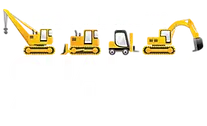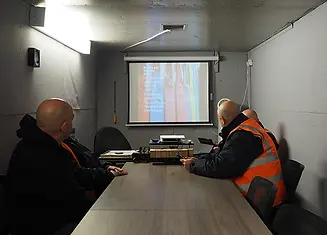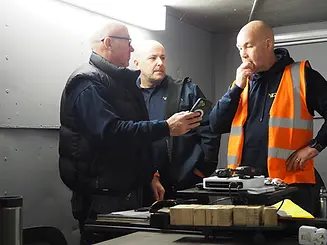
Slinger Signaller Training in Manchester
Fully accredited Slinger Signaller Training courses. 1 to 2 day course, depending on experience.



Why Pro-Trainers UK?
Trading in Manchester for 15 years
Thousands of satisfied customers
Nationally recognised accreditation
Comprehensive course offering

Slinger Signaller Training Courses
Pro Trainers UK is an accredited lifting and banksman training organisation in Manchester with the I.T.S.S.A.R. and National Plant (NPORS) training bodies. Our training is delivered to an exceptional standard and is monitored regularly to ensure quality. Our slinger signaller training certification is nationally recognised and can be used nationwide.
Our Slinger Signaller Training courses include:
-
Certification options for Quality Assurance, NPORS, and ITSSAR
-
Full Certification and Test Fees
-
Provision of ID card with photograph
-
Certificate of Basic Training
-
A detailed course manual with working exercises (except Refresher courses)
-
Slinger Signaller Training courses are available onsite and at our training centre
We offer two course formats to suit your schedule:
-
Scheduled Courses – Held during the third week of every month. These sessions are ideal for individuals or businesses looking to book in advance and follow a regular training calendar.
-
On-Demand Courses – Prefer different dates? Submit an enquiry and we’ll arrange training at a time that works for you.
Accreditations



Our Slinger Signaller Training Courses

Slinger Signaller Novice Course
At Pro Trainers UK, we are dedicated to providing top-tier lifting and banksman training that goes above and beyond industry standards. Our slinger signaller courses are meticulously crafted to ensure that your team achieves the highest level of operational excellence. We take great pride in our thorough assessment reports, custom-tailored to each course, offering you the assurance that your employees are fully proficient in all aspects of the training.
Course Name: Slinger Signaller Training
Target Audience: Ideal for novices or operators seeking to expand their expertise to include other types of lifting equipment.
Duration: The duration varies depending on specific requirements, typically spanning 2 days with a maximum of 3 participants.
Availability: Offered both onsite and at our training centre for your convenience.
Key Learning Outcomes:
-
Gain proficiency in slinger signaller operation.
-
Enhance employability with a broader skill set encompassing various lifting machinery.
-
Receive a comprehensive certification upon completion of the slinger signaller training course.

Key Assessment Areas
Pro Trainers UK adheres to the guidelines set by LANTRA, NPORS & ITSSAR, ensuring our staff are trained to the highest standard. The following assessment report outlines the competency of participants in our Slinger Signaller course.
Safety Awareness Session:
-
Covered relevant legislations: Health & Safety at Work Act 1974, PUWER 1998, LOLER 1998.
-
Discussed safe working loads, inspection of lifting tackle, and general operating practices.
-
Provided instruction on methods of slinging and weight estimation.
Pre-Lifting Checks:
-
Confirmed load details with crane operator, including weight, route, and signal code.
-
Assessed the area and landing spot for potential hazards and suitability.
-
Checked load for weight, stability, and security.
Lifting Accessories Checks:
-
Ensured lifting accessories underwent a thorough examination.
-
Selected appropriate accessories based on load type and size, considering safe working loads.
-
Inspected accessories for serviceability and suitability for use.
Lifting and Moving:
-
Properly attached lifting accessories to each load, considering angular stress.
-
Checked hoist line alignment before lifting and conducted a trial lift to confirm stability and weight.
-
Maintained full control of the load using effective hand signals, ensuring safety of all personnel involved.
Used tag lines when necessary to control load movement.
Post-Lifting Checks:
-
Safely landed the load in the designated area.
-
Removed accessories from the load and cleared any remaining equipment.
Inspected accessories for damage, defect, or wear and properly stored them.
Testing and Certification Details

The Practical Test and Its Importance
Our slinger signaller training culminates in a practical test, a crucial step towards certification. This test, validated and approved by either NPORS, ITSSAR or Quality Assurance (depending on your preferences) is a comprehensive evaluation of your crane operating skills. Passing this test signifies that you have attained the proficiency required to operate as a slinger signaller safely and effectively. It's important to note that this test is not just a formality; it's a rigorous assessment that ensures you are ready for real-world operations.

Three stages of Training
Basic Training: This is where you'll learn the fundamentals of hoist and winch operation, including handling and safety procedures. It's the first step towards becoming a competent operator.
Specific Job Training: Tailored to your workplace, this stage includes training on specific handling attachments and knowledge of the work environment.
Familiarisation Training: Conducted on the job under close supervision, this stage allows you to apply what you've learned in a practical setting, ensuring you're comfortable and competent in your specific work context.

Test Revisions & Expectations
The practical test has undergone revisions to ensure it remains relevant and challenging. These changes include an updated marking sheet, where certain faults may now score higher, reflecting the emphasis on safety and precision in operations. Additionally, the test now includes a written component, where candidates are expected to achieve a minimum score of 80%. This includes both multiple-choice and open questions, ensuring a comprehensive understanding of both practical and theoretical aspects of s;linger signaller operation.
FAQ's
What is the purpose of the Slinger Signaller course?
The Slinger Signaller course trains individuals to safely direct crane operators during lifting operations. Participants learn to communicate effectively using hand signals and ensure the safe movement of loads on construction sites.
Who should attend the Slinger Signaller course?
This course is ideal for individuals involved in lifting operations on construction sites, including construction workers, riggers, and site supervisors.
What topics are covered in the course?
The course covers essential safety regulations, such as the Health & Safety at Work Act. Participants learn about sling types, lifting accessories, load estimation, and effective communication methods.
Is there any prerequisite for attending the course?
While there are no formal prerequisites, participants should have a basic understanding of construction site operations and lifting equipment.
What skills will participants develop during the course?
Participants will learn how to conduct pre-lifting checks, select appropriate lifting accessories, communicate effectively with crane operators using hand signals, and ensure the safe movement of loads.
How long is the course?
The duration of the course may vary, but typically it spans over a two days, covering both theoretical and practical aspects of slinger signalling.
Is there a practical assessment component?
Yes, participants will undergo practical assessments to demonstrate their ability to sling and signal loads safely under the supervision of our experienced trainers.
Will participants receive a certification upon completion?
Yes, participants who successfully complete the course will receive a certification accredited by NPORS & ITSSAR, indicating their competency as a Slinger Signaller.
Is the course conducted onsite or at a training centre?
Our Slinger Signaller course can be conducted both onsite and at our training centre, providing flexibility for employers and individuals.
How can I book a Slinger Signaller course for my team?
To book a course or inquire about availability, please contact our training coordinator who will assist you with scheduling and any other queries you may have.
Testimonials
Our Team.
Welcome to the heart of Pro Trainers UK, where our strength lies in the expertise and dedication of our team. Behind every successful training course is a group of passionate professionals committed to providing the highest standard of heavy machinery training.
Our Lifting & Banksman Training Courses
Find our Training Centre in Manchester
Our operating Areas include Altrincham, Ardwick, Ashton under Lyne, Blackfriars, Bramhall, Broughton, Bury, Cheetham Hill, Chorlton cum Hardy, Collyhurst, Denton, Didsbury, Droylsden, Dukinfield, Eccles, Failsworth, Gatley, Heaton Moor, Hulme Hall, Hyde, Irlam, Longford, Manchester, Marple, Middleton, Moss Side, Oldham, Partington, Pendleton, Prestwich, Radcliffe, Ringway, Rusholme, Sale, Stalybridge, Stepping Hill, Stockport, Stretford, Swinton, Trafford, Urmston, Walkden, Whitefield, Woodley, Wythenshawe.
.png)









